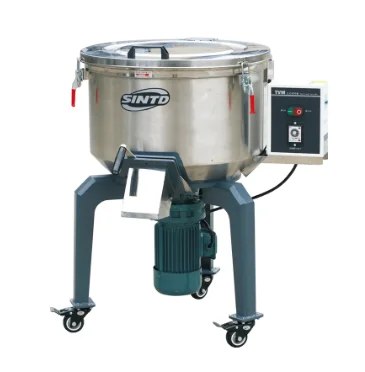Introduction to material mixers
Are you curious about the secret behind manufacturing high-quality plastic products? Look no further than material mixers! These unsung heroes of the plastic industry play a crucial role in ensuring that your favorite everyday items are produced with precision and excellence. Whether it's creating durable packaging materials or innovative consumer goods, material mixers are an essential component of any plastic manufacturing process. In this blog post, we will explore the different types of material mixers and delve into the numerous benefits they bring to the table. So, let's dive right in and discover how these mighty machines make a world of difference in plastic production!
The different types of material mixers
When it comes to mixing materials in plastic manufacturing, there are several types of material mixers that can be used. Each type has its own unique features and advantages, allowing manufacturers to choose the best option for their specific needs.
One common type of material mixer is the paddle mixer. This mixer uses rotating paddles or blades to blend different materials together. It is often used for dry blending or mixing powders, as it provides a gentle yet thorough mixing action.
Another type of material mixer is the high-shear mixer. As the name suggests, this mixer generates high levels of shear force to mix materials effectively. It is particularly useful when working with viscous substances or when a more intense blending action is required.
For larger-scale operations, ribbon blenders are often employed. These mixers consist of a large trough with spiral ribbons inside that move materials in opposite directions. This creates a rolling motion that ensures uniform mixing throughout the batch.
In addition to these types, there are also static mixers which do not have any moving parts but instead rely on internal elements like baffles and channels to create turbulence and achieve proper blending.
Each type of material mixer offers its own set of benefits depending on factors such as batch size, desired level of homogeneity, and specific requirements for the final product. By choosing the right type of material mixer for their needs, plastic manufacturers can ensure efficient production processes and consistent quality in their products.

The benefits of using material mixers in plastic manufacturing
Material mixers play a crucial role in the plastic manufacturing industry, offering numerous benefits that contribute to efficient and high-quality production processes. These mixers are designed to blend different types of materials together, ensuring consistency and uniformity in the final product.
One of the key advantages of using material mixers is improved product quality. By thoroughly blending raw materials, such as resins, colorants, and additives, material mixers help eliminate inconsistencies or variations within the plastic mixture. This results in a more reliable end product that meets specific quality standards.
Additionally, material mixers enhance productivity by reducing processing time. With their ability to quickly and effectively combine various ingredients, these machines streamline production processes and enable manufacturers to meet tight deadlines while maintaining high output levels.
Furthermore, using material mixers ensures safety in plastic manufacturing facilities. By automating the mixing process and eliminating manual handling of materials.

Conclusion
Material mixers play a crucial role in the plastic manufacturing industry, ensuring that the ingredients used in the production process are thoroughly blended and mixed to create high-quality plastic products. They come in various types, including batch mixers, continuous mixers, and static mixers, each with its own unique features and benefits.
By using material mixers in plastic manufacturing, manufacturers can experience numerous advantages. Material mixers ensure consistent mixing of materials, resulting in uniform product quality. This is essential for industries that require precise measurements and ratios to meet specific standards or customer requirements.
Material mixers improve productivity by reducing mixing time. With efficient mixing processes facilitated by these machines, manufacturers can significantly increase their output without compromising on quality.
Furthermore,fmaterialmixe rs enhance safety by minimizing worker exposure to hazardous chemicals during manual mixing processes. Automated mixer systems provide a safer working environment while maintaining consistent results.
Material mixers play an integral role in plastic manufacturing as they ensure thorough blending of ingredients to achieve high-quality end products consistently.From improving efficiency and productivity and enhancing safety measures within the workplace – material mix ers offer significant benefits for manufacturers across various industries.







